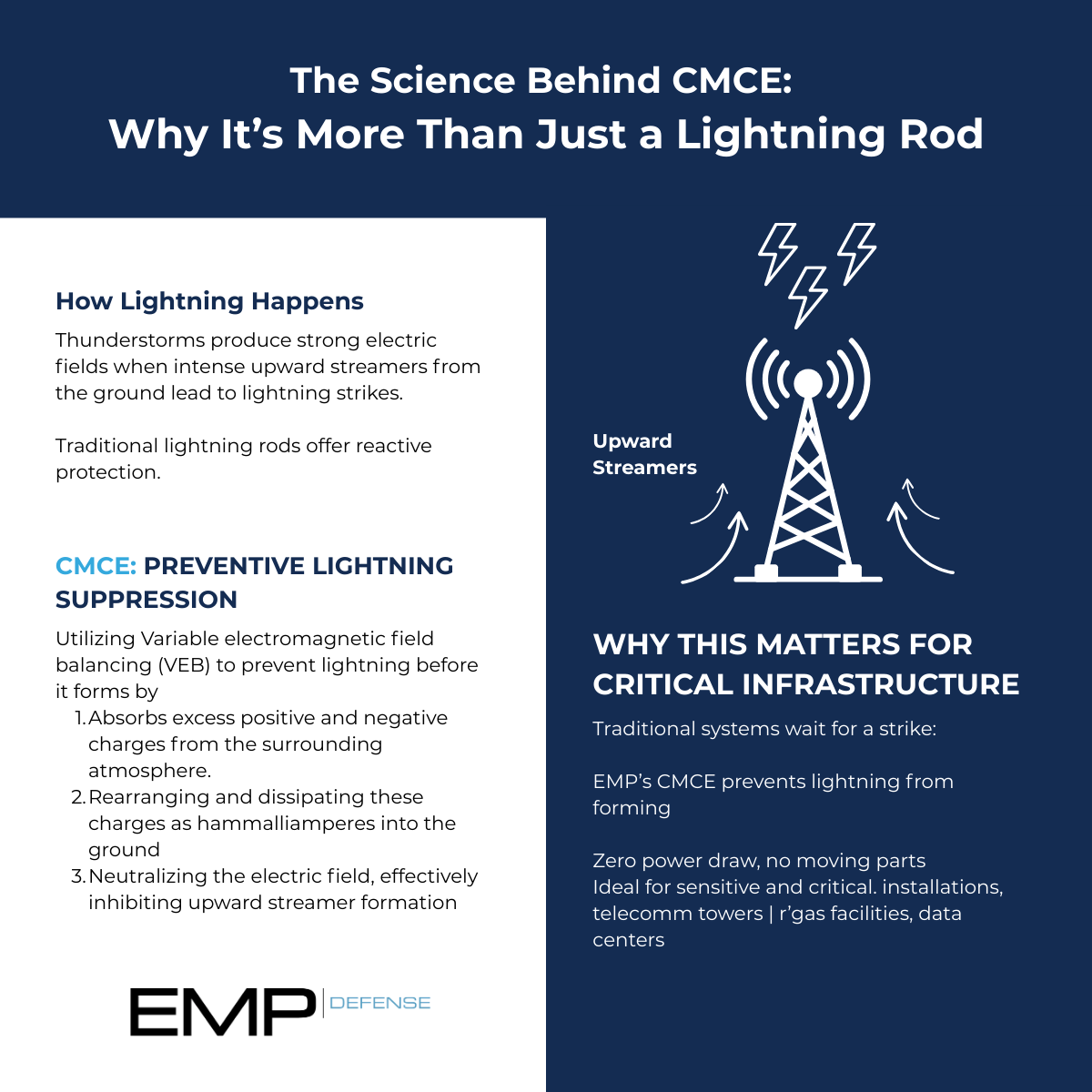The Science Behind CMCE: Why It’s More Than Just a Lightning Rod
Understanding the Lightning Threat
Lightning is one of nature’s most powerful and unpredictable forces. It forms when electric charges build up in storm clouds, eventually creating a high-voltage imbalance between the clouds and the ground. This imbalance is resolved when the atmosphere breaks down electrically, forming a conductive path—resulting in a lightning strike. Contrary to popular belief, the ground isn’t a passive bystander in this process. Structures and surfaces on the ground can emit "upward streamers", invisible electrical leaders that rise to meet the downward-moving lightning. These streamers often determine where the strike will land.
For decades, the primary tool for mitigating lightning damage has been the traditional lightning rod, or air terminal. These are designed to safely attract lightning and route the massive electrical discharge into the ground. While effective in conducting electricity away from critical structures, this approach is reactive, not preventive. It assumes lightning is inevitable and simply aims to manage the consequences. In industries where even one strike can cause catastrophic damage, this is no longer enough.
What Makes CMCE Different?
The CMCE (Charge Management and Control Equipment) device offers a revolutionary approach to lightning protection—one that doesn’t just manage strikes, but helps prevent them entirely. Rather than waiting for lightning to strike and guiding it safely away, CMCE works proactively by influencing the electrical environment around a structure to prevent the strike from forming in the first place.
At the core of CMCE technology is a phenomenon called Variable Electromagnetic Field Balancing (VEB). This system actively redistributes static charges in the atmosphere surrounding a protected area. By absorbing excess electrical charge from both the structure and the air, the CMCE device neutralizes the conditions necessary for lightning to form. This significantly reduces the potential for upward streamer development—the very signal that attracts lightning to begin with.
The CMCE achieves this through continuous emission and grounding of harmless low-magnitude currents (in the milliamp range), effectively balancing the local electric field. These actions disrupt the electrical buildup needed for a strike, especially in the critical zone within 300 meters of the device.
Verified by Science and Independent Testing
This technology isn’t just theoretical. The CMCE device has been lab-tested and field-proven across a wide range of applications and weather conditions. Independent validation from institutions like the Instituto Tecnológico de la Energía (ITE) has confirmed its ability to operate continuously, manage electric fields effectively, and withstand extreme lightning-related conditions without degrading or failing.
What sets CMCE apart from fringe or unproven suppression methods is its scientific credibility. The principles behind it are rooted in well-documented electromagnetic behavior, and peer-reviewed studies into electro-atmospheric charge dynamics lend further support to its design. The core mechanism—controlling the rise of the ground potential and maintaining equilibrium within the protected zone—has been modeled and validated with real-world results.
Applications for Critical Infrastructure
The industries adopting CMCE aren’t just looking for the next flashy gadget—they’re managing high-risk, high-value operations where downtime, fires, or equipment loss due to lightning could cost millions. Whether it's a data center filled with sensitive servers, an offshore oil rig, or a remote telecommunications tower, these sectors demand maximum uptime and minimal risk.
CMCE’s advantages go far beyond strike prevention. It requires no power supply, has no moving parts, and operates silently and autonomously 24/7. That makes it ideal for installations in remote or unmanned environments, especially where maintenance and monitoring are difficult.
Why It’s Time to Rethink Lightning Protection
As infrastructure becomes more complex and valuable, the risks associated with lightning are only growing. Traditional lightning rods still have a role to play, but they don't prevent damage—they manage it. CMCE offers a transformative upgrade to the way we think about lightning protection. By neutralizing risk before a strike occurs, it opens a new frontier in safety, reliability, and peace of mind.
Whether you're protecting people, assets, or data, CMCE delivers a layer of defense that lightning rods never could: prevention.

